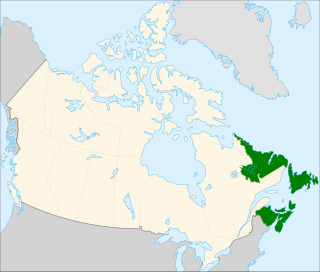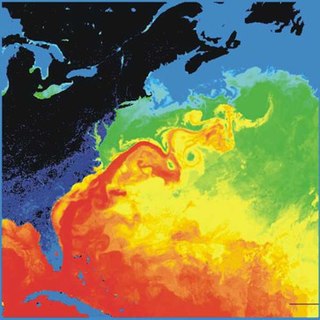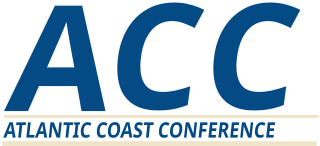
The Atlantic Ocean is the second largest of the world's oceans, with an area of about 106,460,000 square kilometers. It covers approximately 20 percent of the Earth's surface and about 29 percent of its water surface area. It separates the "Old World" from the "New World".

The North Atlantic Current (NAC), also known as North Atlantic Drift and North Atlantic Sea Movement, is a powerful warm western boundary current within the Atlantic Ocean that extends the Gulf Stream northeastward.

The Atlantic slave trade or transatlantic slave trade involved the transportation by slave traders of enslaved African people, mainly to the Americas. The slave trade regularly used the triangular trade route and its Middle Passage, and existed from the 16th to the 19th centuries. The vast majority of those who were enslaved and transported in the transatlantic slave trade were people from central and western Africa, who had been sold by other West Africans to Western European slave traders, who brought them to the Americas. The South Atlantic and Caribbean economies especially were dependent on the supply of secure labour for the production of commodity crops, making goods and clothing to sell in Europe. This was crucial to those western European countries which, in the late 17th and 18th centuries, were vying with each other to create overseas empires.

Atlantic Canada, also called the Atlantic provinces, is the region of Canada comprising the four provinces located on the Atlantic coast, excluding Quebec: the three Maritime provinces – New Brunswick, Nova Scotia, and Prince Edward Island – and the easternmost province of Newfoundland and Labrador. The population of the four Atlantic provinces in 2016 was about 2,300,000 on half a million km2. The provinces combined had an approximate GDP of $121.888 billion in 2011.

The East Coast of the United States, also known as the Eastern Seaboard, the Atlantic Coast, and the Atlantic Seaboard, is the coastline along which the Eastern United States meets the North Atlantic Ocean. The coastal states that have shoreline on the Atlantic Ocean are, from north to south, Maine, New Hampshire, Massachusetts, Rhode Island, Connecticut, New York, New Jersey, Delaware, Maryland, Virginia, North Carolina, South Carolina, Georgia, and Florida.

A subtropical cyclone is a weather system that has some characteristics of a tropical and an extratropical cyclone.

The Atlantic coastal plain is a physiographic region of low relief along the East Coast of the United States. It extends 2,200 miles (3,500 km) from the New York Bight southward to a Georgia/Florida section of the Eastern Continental Divide, which demarcates the plain from the ACF River Basin in the Gulf Coastal Plain to the west. The province is bordered on the west by the Atlantic Seaboard fall line and the Piedmont plateau, to the east by the Atlantic Ocean, and to the south by the Floridian province. The Outer Lands archipelagic region forms the insular northeasternmost extension of the Atlantic coastal plain.

The Atlantic Coast Line Railroad is a former U. S. Class I railroad from 1900 until 1967, when it merged with long-time rival Seaboard Air Line Railroad to form the Seaboard Coast Line Railroad. Much of the original ACL network has been part of CSX Transportation since 1986.

The Slave Coast is a historical name formerly used for parts of coastal West Africa along the Bight of Benin. The name is derived from the region's history as a major source of African slaves during the Atlantic slave trade from the early 16th century to the late 19th century. Other nearby coastal regions historically known by their prime colonial export are the Gold Coast, the Ivory Coast, and the Pepper Coast.

An Atlantic hurricane or tropical storm is a tropical cyclone that forms in the Atlantic Ocean, usually between the months of June and November. A hurricane differs from a cyclone or typhoon only on the basis of location. A hurricane is a storm that occurs in the Atlantic Ocean and northeastern Pacific Ocean, a typhoon occurs in the northwestern Pacific Ocean, and a cyclone occurs in the south Pacific or Indian Ocean.

The Atlanta, Birmingham and Atlantic Railway was formed in 1914 as a reorganization of the Atlanta, Birmingham and Atlantic Railroad, which had been created in 1905 to purchase the Atlantic and Birmingham Railway and extend its track into Birmingham, Alabama, from an end point at Montezuma, Georgia.

The Atlanta, Birmingham and Coast Railroad was organized in 1926 to replace the Atlanta, Birmingham and Atlantic Railway. The AB&C was controlled by the Atlantic Coast Line Railroad, which owned a majority of the stock. In 1944 it reported 763 million net ton-miles of revenue freight and 33 million passenger-miles; at the end of that year it operated 639 miles of road and 836 miles of track.

The Wake Forest Demon Deacons football team represents Wake Forest University in the sport of American football. The Demon Deacons compete in the Football Bowl Subdivision (FBS) of the National Collegiate Athletic Association (NCAA) and the Atlantic Division of the Atlantic Coast Conference (ACC). Wake Forest plays its home football games at BB&T Field and is currently coached by Dave Clawson.
The ACC Men's Basketball Tournament is the conference championship tournament in basketball for the Atlantic Coast Conference (ACC). The tournament has been held every year since 1954, the ACC's first season. It is a single-elimination tournament and seeding is based on regular season records. The winner, declared conference champion, receives the conference's automatic bid to the NCAA men's basketball tournament.

The Gulf Stream, together with its northern extension the North Atlantic Drift, is a warm and swift Atlantic ocean current that originates in the Gulf of Mexico and stretches to the tip of Florida, and follows the eastern coastlines of the United States and Newfoundland before crossing the Atlantic Ocean. The process of western intensification causes the Gulf Stream to be a northward accelerating current off the east coast of North America. At about 40°0′N30°0′W, it splits in two, with the northern stream, the North Atlantic Drift, crossing to Northern Europe and the southern stream, the Canary Current, recirculating off West Africa.

The Florida Gulf Coast Eagles refer to the fifteen sports teams representing Florida Gulf Coast University in Fort Myers, Florida in intercollegiate athletics, including men and women's basketball, cross country, golf, soccer, and tennis; women's-only: softball, swimming and diving, indoor volleyball, and sand volleyball; and men's-only: baseball. The Eagles compete in the NCAA Division I and are members of the Atlantic Sun Conference (ASUN). FGCU is also notable as the youngest institution competing in NCAA Division I, having been officially founded in 1991 and started classes in 1997.
The 1965 Clemson Tigers football team represented Clemson University during the 1965 NCAA University Division football season.

The 2013–14 ACC men's basketball season began with practices in October 2013, followed by the start of the 2013–14 NCAA Division I men's basketball season in November. Conference play started in early January 2014 and concluded in March with the 2014 ACC Men's Basketball Tournament at the Greensboro Coliseum in Greensboro. The 2013–14 season marked the first season for three new additions to the conference from the Big East: Notre Dame, Pittsburgh, and Syracuse. It was also the final ACC season for conference charter member Maryland, which left after the season for the Big Ten Conference.

















